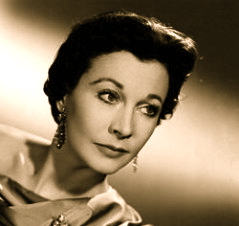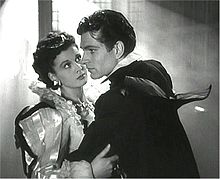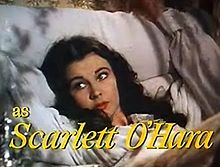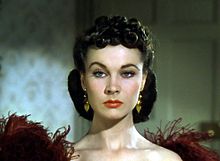Vivien Leigh

Vivien Leigh

photo taken in 1955
Vivien Leigh, Lady Olivier (5 November 1913 – 8 July 1967) was a British actress. She won the Best Actress Academy Award for her portrayal of Blanche DuBois in A Streetcar Named Desire (1951), a role she also played on stage in London‘s West End, as well as for her portrayal of the southern belle Scarlett O’Hara, alongside Clark Gable, in the American Civil War drama Gone with the Wind.
She was a prolific stage performer, frequently in collaboration with her then-husband,Laurence Olivier, who directed her in several of her roles. During her 30-year stage career, she played roles ranging from the heroines of Noël Coward and George Bernard Shaw comedies to classic Shakespearean characters such as Ophelia, Cleopatra, Juliet and Lady Macbeth.
Lauded for her beauty, Leigh felt that it sometimes prevented her from being taken seriously as an actress. However, ill health proved to be her greatest obstacle. For much of her adult life Leigh suffered from bipolar disorder. She earned a reputation for being difficult to work with, and her career suffered periods of inactivity. She also suffered recurrent bouts of chronic tuberculosis, first diagnosed in the mid-1940s. Leigh and Olivier divorced in 1960, and she worked sporadically in film and theatre until her death from tuberculosis in 1967.
She is ranked 16th on AFI’s 100 Years…100 Stars list, unveiled on 15 June 1999 by the American Film Institute.
First marriage
Vivian Hartley met (Herbert) Leigh Holman, a barrister 13 years her senior, in 1931. Despite his disapproval of “theatrical people”, they were married on 20 December 1932, and she terminated her studies at RADA. On 12 October 1933, she gave birth to a daughter, Suzanne, later Mrs. Robin Farrington, who, decades later, would make Vivien Leigh a grandmother three times over.
Early career
 Leigh’s friends suggested she take a small role in the film Things Are Looking Up, which marked her film debut. She engaged an agent, John Gliddon, who believed that “Vivian Holman” was not a suitable name for an actress. After rejecting his suggestion, “April Morn”, she took “Vivian Leigh” as her professional name. Gliddon recommended her to Alexander Korda as a possible film actress, but Korda rejected her as lacking potential. She was cast in the play The Mask of Virtue in 1935, and received excellent reviews, followed by interviews and newspaper articles. One such article was from the Daily Express, in which the interviewer noted “a lightening change came over her face”, which was the first public mention of the rapid changes in mood that became characteristic of her. John Betjeman, the future Poet Laureate, also wrote about her, describing her as “the essence of English girlhood.” Korda attended her opening-night performance, admitted his error, and signed her to a film contract, with the spelling of her name revised to “Vivien Leigh”. She continued with the play; but, when Korda moved it to a larger theatre, Leigh was found to be unable to project her voice adequately or to hold the attention of so large an audience, and the play closed soon after.
Leigh’s friends suggested she take a small role in the film Things Are Looking Up, which marked her film debut. She engaged an agent, John Gliddon, who believed that “Vivian Holman” was not a suitable name for an actress. After rejecting his suggestion, “April Morn”, she took “Vivian Leigh” as her professional name. Gliddon recommended her to Alexander Korda as a possible film actress, but Korda rejected her as lacking potential. She was cast in the play The Mask of Virtue in 1935, and received excellent reviews, followed by interviews and newspaper articles. One such article was from the Daily Express, in which the interviewer noted “a lightening change came over her face”, which was the first public mention of the rapid changes in mood that became characteristic of her. John Betjeman, the future Poet Laureate, also wrote about her, describing her as “the essence of English girlhood.” Korda attended her opening-night performance, admitted his error, and signed her to a film contract, with the spelling of her name revised to “Vivien Leigh”. She continued with the play; but, when Korda moved it to a larger theatre, Leigh was found to be unable to project her voice adequately or to hold the attention of so large an audience, and the play closed soon after.
In 1960, Leigh recalled her ambivalence towards her first experience of critical acclaim and sudden fame, commenting, “some critics saw fit to be as foolish as to say that I was a great actress. And I thought, that was a foolish, wicked thing to say, because it put such an onus and such a responsibility onto me, which I simply wasn’t able to carry. And it took me years to learn enough to live up to what they said for those first notices. I find it so stupid. I remember the critic very well and have never forgiven him.”
Meeting Laurence Olivier
 Leigh with Laurence Olivier in Fire Over England (1937), their first collaboration
Leigh with Laurence Olivier in Fire Over England (1937), their first collaboration
Laurence Olivier saw Leigh in The Mask of Virtue, and a friendship developed after he congratulated her on her performance. Olivier and Leigh began an affair after acting as lovers in Fire Over England (1937), when Olivier was married to actress Jill Esmond. During this time, Leigh read the Margaret Mitchell novel Gone with the Wind and instructed her American agent to suggest her to David O. Selznick, who was planning a film version. She remarked to a journalist, “I’ve cast myself as Scarlett O’Hara“; and The Observer film critic C. A. Lejeune recalled a conversation of the same period in which Leigh “stunned us all” with the assertion that Olivier “won’t play Rhett Butler, but I shall play Scarlett O’Hara. Wait and see.”
Despite her relative inexperience, Leigh was chosen to play Ophelia to Olivier’s Hamlet in an Old Vic Theatre production staged at Elsinore, Denmark.[14] Olivier later recalled an incident when her mood rapidly changed as she was preparing to go onstage. Without apparent provocation, she began screaming at him, before suddenly becoming silent and staring into space. She was able to perform without mishap; and, by the following day, she had returned to normal with no recollection of the event. It was the first time Olivier witnessed such behaviour from her. They began living together, as their respective spouses had each refused to grant either of them a divorce. Under the moral standards then enforced by the motion picture industry, their relationship had to be kept from public view. Leigh appeared with Robert Taylor, Lionel Barrymore and Maureen O’Sullivan in A Yank at Oxford (1938), the first of her films to receive attention in the United States. During production, she developed a reputation for being difficult and unreasonable; and Korda instructed her agent to warn her that her option would not be renewed if her behaviour did not improve. Her next role was in St. Martin’s Lane (1938) with Charles Laughton.
Achieving international success
Olivier had been attempting to broaden his film career. He was not well known in the United States despite his success in England, and earlier attempts to introduce him to the American market had failed. Offered the role of Heathcliff in Samuel Goldwyn‘s production of Wuthering Heights (1939), he travelled to Hollywood, leaving Leigh in London. Goldwyn and the film’s director, William Wyler, offered Leigh the secondary role of Isabella; but she refused, preferring the role of Cathy, which went to Merle Oberon.
 Leigh in the trailer for Gone with the Wind (1939)
Leigh in the trailer for Gone with the Wind (1939)
Hollywood was in the midst of a widely publicized search to find an actress to portray Scarlett O’Hara in David O. Selznick‘s production of Gone with the Wind (1939). Leigh’s American theatrical agent was the London representative of the Myron Selznick Agency (Myron was David’s brother). In February 1938, Leigh asked that she be allowed to play Scarlett O’Hara. Selznick, who watched her performance that month in Fire Over England and A Yank at Oxford, thought her to be excellent but in no way a possible Scarlett, as she was “too British”. Leigh travelled to Los Angeles to be with Olivier and to try to convince Selznick that she was Scarlett. When Myron Selznick, who also represented Olivier, met Leigh, he felt that she possessed the qualities his brother was searching for. Myron Selznick took Leigh and Olivier to the set where the burning of the Atlanta Depot scene was being filmed and introduced Leigh, telling his brother, “Hey, genius, meet your Scarlett O’Hara.” The following day, Leigh read a scene for Selznick, who organised ascreen test and wrote to his wife, “She’s the Scarlett dark horse and looks damn good. Not for anyone’s ear but your own: it’s narrowed down to Paulette Goddard, Jean Arthur, Joan Bennett and Vivien Leigh”. The director, George Cukor, concurred and praised Leigh’s “incredible wildness”; she secured her role as Scarlett soon after.
Filming proved difficult for Leigh. Cukor was dismissed and replaced by Victor Fleming, with whom Leigh frequently quarrelled. She and Olivia de Havilland secretly met with Cukor at night and on weekends for his advice about how they should play their parts. She befriended Clark Gable, his wife Carole Lombard and Olivia de Havilland; but she clashed with Leslie Howard, with whom she was required to play several emotional scenes. Leigh was sometimes required to work seven days a week, often late into the night, which added to her distress; and she missed Olivier, who was working in New York. She said to Laurence Olivier on a long-distance call, “Puss, my puss, how I hate film acting! Hate, hate, and never want to do another film again!”
In 2006, Olivia de Havilland responded to claims of Leigh’s manic behaviour during filming Gone with the Wind, published in a biography of Olivier. She defended Leigh, saying, “Vivien was impeccably professional, impeccably disciplined on Gone with the Wind. She had two great concerns: doing her best work in an extremely difficult role and being separated from Larry [Olivier], who was in New York.”
Gone with the Wind brought Leigh immediate attention and fame; but she was quoted as saying, “I’m not a film star – I’m an actress. Being a film star – just a film star – is such a false life, lived for fake values and for publicity. Actresses go on for a long time and there are always marvelous parts to play.” Among the 10 Academy Awards won by Gone with the Wind was a Best Actress award for Leigh, who also won a New York Film Critics Circle Award for Best Actress.



